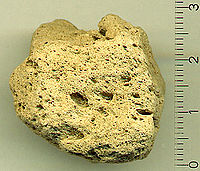
Photo from wikipedia
The Lower Cretaceous presalt section of the Kwanza Basin (Angola) is in the spotlight following the discoveries of petroleum systems in this basin, and more generally in the South Atlantic.… Click to show full abstract
The Lower Cretaceous presalt section of the Kwanza Basin (Angola) is in the spotlight following the discoveries of petroleum systems in this basin, and more generally in the South Atlantic. These systems are mostly composed of continental carbonates in close association with volcanic rocks. This work is focused on the study of an offshore Kwanza presalt volcanic sequence characterized as Valanginian trachytic subaerial lava flows. A detailed petrological analysis of the altered trachyte in association with fluid inclusion microthermometry was conducted in order to depict the initial mineralogy (albite, sanidine, titanomagnetite) and obtain a paragenetic sequence (quartz, siderite, kaolinite, calcite). Thermodynamic equilibrium modelling of the trachytes alteration by meteoric fluids, over a range of temperatures (25 °C–200 °C) and CO2 partial pressure (pCO2: 0.01 mbar to 100 bar), were performed with PHREEQC, and compared to the observed paragenetic sequence. Some numerical simulations reflect the observed paragenesis. As a result, the pCO2 is constrained by the occurrence of siderite (from 0.1 bar at 50 °C to 30 bar at 125 °C) and kaolinite (from 0.2 bar at 50 °C to 1.2 bar at 125 °C). The simulations emphasize the need for a high pCO2 in the hydrothermal system, to achieve the observed trachyte transformation. After reaching equilibrium with the trachytes, the simulated fluids highlight a mid-alkaline to near neutral pH with high Fe, HCO3+CO3, and alkali concentrations. The palaeofluids could have evolved from Ca- and Mg-rich to Ca- and Mg-poor with increasing temperature. Inversely, Si concentrations are positively correlated with increasing temperatures. This methodology, integrating a petrological approach and numerical simulations, proves to be a powerful tool leading to better understanding of the proxies (pCO2, temperature, redox conditions) controlling paragenesis. To push further, these simulations are also a step toward improved understanding of palaeofluid evolutions in presalt systems and better prediction of reservoir quality.
Journal Title: Marine and Petroleum Geology
Year Published: 2017
Link to full text (if available)
Share on Social Media: Sign Up to like & get
recommendations!